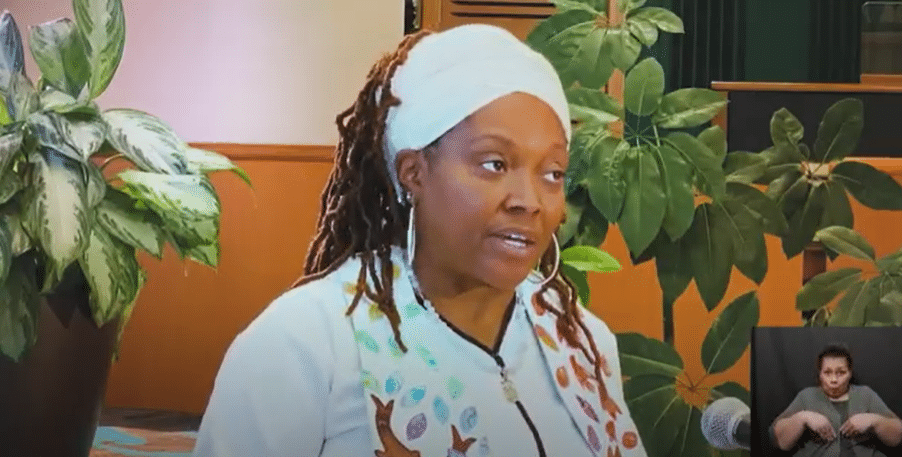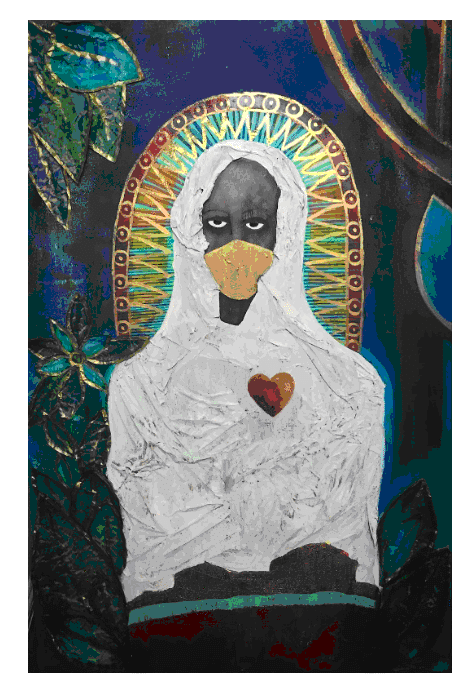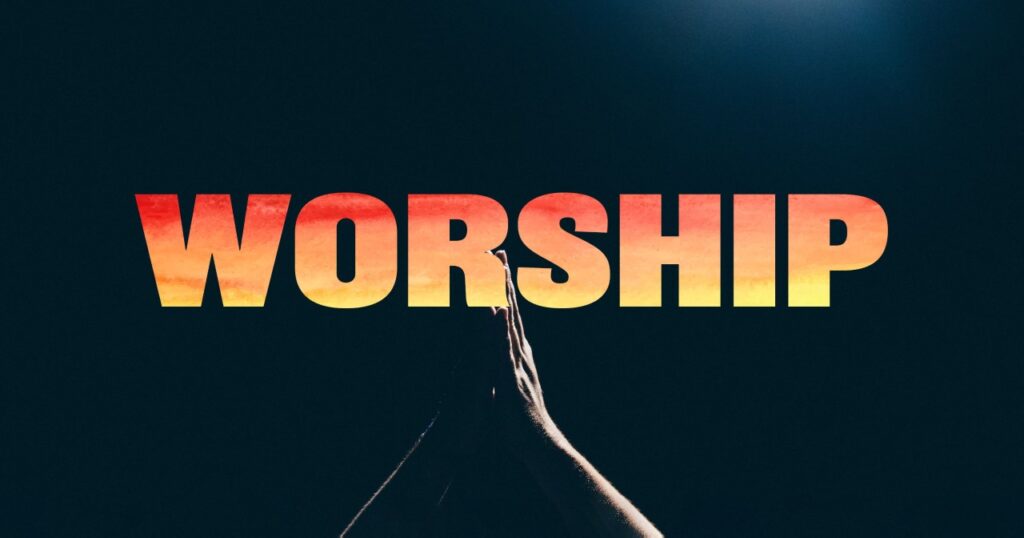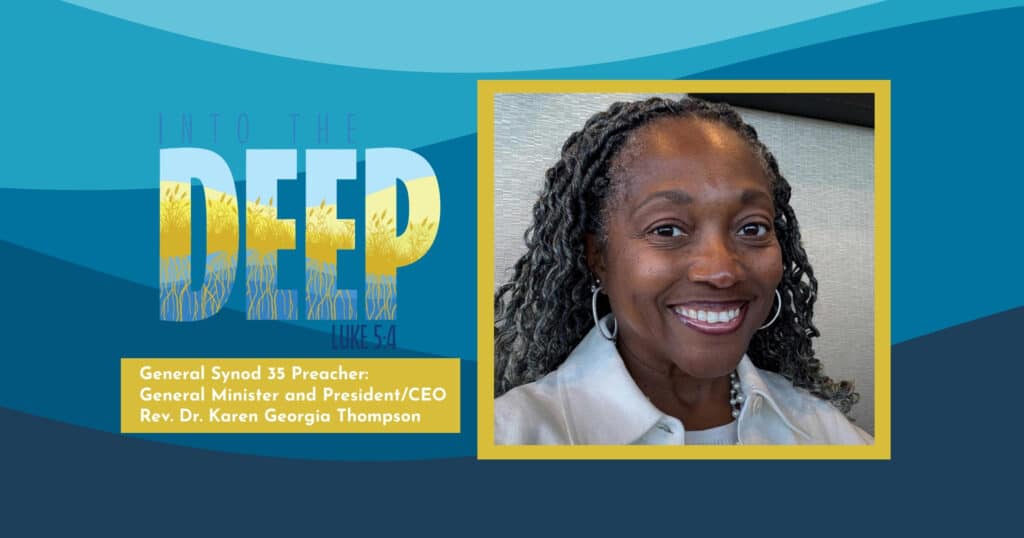Closing worship focuses on breathing again, helping those who can’t
The United Church of Christ’s 33rd General Synod closed July 18 with a stirring worship service that looked back at tragic world events since the denomination’s last biennial gathering, with a call for a new vision for the future.
Addressing “air” and “breath” as the last of the three elements that are needed for living things to be “rooted,” the service centered on breathing. Traditional worship components, shared virtually in a video service in fresh and creative ways, were punctuated by the beats of a calming “breath ritual.” The ritual was taught and explained early in the service by the Rev. Vahisha Hasan, executive director of Movement in Faith, then used repeatedly throughout the service.
Original songs and familiar hymns performed by professional musicians, church choirs gathered on Zoom, and children … An interpretive dance … A Native American ritual … A provocative poem … Liturgical artwork … Original videos and instrumental music … All these, woven through the service, carried theme. The Sunday service also included Communion, led by the UCC executive officers, shown on video from the “sacred spaces” of their own homes, using elements of their choice.
‘I can’t breathe’
In her sermon, the Rev. Karen Georgia Thompson, associate general minister Wider Church ministries and Operations and co-executive of Global Ministries, recalled the dying words of George Floyd. He uttered, “I can’t breathe,” when he was killed in May 2020 by a Minneapolis police officer kneeling on his neck while he was in custody. “We are holding our breaths,” Thompson said. Then she asked, “What will it take for us to breathe again?”

Thompson then cited a New York Times special report, “Three Words. 70 Cases. The Tragic History of ‘I Can’t Breathe,” prepared a month after Floyd’s murder. It uncovered 70 instances in the previous 10 years in which persons, ranging in age from 19 to 65, had died in police custody. They included a doctor, a nurse, an engineer and a soldier, she noted. More than half of the victims were black, and most of the incidents evolved from non-violent crimes, 911 calls about suspicious behavior, or concerns about the victims’ mental health. Thompson read aloud the names of a dozen of these lesser-known victims, including Byron Williams, who said “I can’t breathe” 17 times before he died while being held by police.
Thompson then moved on to reviewing the pandemic, sharing her own painful story. On March 20, 2020, as COVID-19 spread through New York City, her otherwise active 85-year-old father, Isaiah Thompson, called her after five days of struggling to breathe. On that day, she remembered, his shortness of breath was obvious over the phone. An ambulance took him to the hospital, but in less than 12 hours, he was dead — “one of millions,” she said, “for whom breath was lost to a health pandemic, ravaging lungs and lives.”
Thompson noted that since January 2020, 150 million infections have been reported, and more than 3 million deaths, worldwide. “We are more isolated than we have ever been,” she said, and warned that even as vaccines have become available, “there are striking differences in the ways in which care and access are provided to populations living on the margins globally.”
‘Time to breathe again’
Thompson acknowledged that the church and church members have been “complicit” in injustices “in every age, and today is no different.” But, she said, “Church, it is time for a new vision. It is time for us to breathe again.” Noting that “I can’t breathe” takes many forms, including racism, inadequate health care, toxicity and pollution, she then asked, “What will it take for us to hear, ‘I am breathing?’”

Thompson drew comparisons between the prophets who wrote on the “tablets” of the Hebrew Bible and the 21st-century “tablets” that her worshipers could pull out and use. She called on them to “write your vision for a just world.” And if they had trouble coming up with one of their own, she urged them to “borrow from those who have gone before,” such as the Rev. Martin Luther King Jr. “Write the vision,” she concluded, “cast the dream, sing a new world into being.”
As her sermon ended, the heartbeats and countdown of the breathing exercise returned. Viewers were invited to meditate on a piece of art, a Madonna-like “Lady of COVID” wearing a mask. Its creator was Shannon Kearse-High of Root & Soil Sacred Space Design. The service’s downloadable bulletin featured the artwork on its front page, and included details of the many original components that were used in the service, as well as the background of the artists. Thompson’s sermon was preceded by a poem, “barely breathing,” that she wrote with Keon Heywood.
Communion in ‘sacred space’
When the time came for Communion, the Rev. Traci Blackmon, associate general minister, Justice and Local Church Ministries, invited worshipers to assemble their own communion elements, “whether they be toast and juice, cookies and milk, bread and wine, or, like me today, biscuits and tea.” She reminded participants that “communion was a meal comprised of the foods that were native to that region,” and encouraged them to use whatever they wanted to from their “sacred space.” Thompson and the Rev. John Dorhauer, general minister and president, joined Blackmon in leading the liturgy, captured on video in their homes.
A ‘testimony of resurrection’
Early in the service, two moving videos, described as “Native Prayers Through the Pandemic,” were shown. They captured how members of the Apsáalooke Nation and the Rocky Mountain Tribal Council erected and lit an installation of seven teepees outside of Billings, Mont., earlier this year, in memory of persons who had died in 2020. But the teepees, the narrators explained, were also a symbol of hope for the future.
In the first video, “The Lodge,” William Snell, a member of the Apsáalooke Nation and executive director of the Pretty Shield Foundation, explained that “when a teepee goes up, we are all united together, we are one.” The bases of the teepees were made of circles of rocks, painted in memory of persons who had died. The second video included dramatic footage of the teepees at night, with the recitation of a prayer.
Later in the service, a dance entitled “Middle Rising” was offered as a “Testimony of Resurrection.” Set to the Amy Grant song “Breath of Heaven,” it was choreographed and performed by Adrienne Hurd, accompanied by Dione McClain-Freeney, and set against the backdrop of Middle Collegiate Church in New York City’s East Village, whose historic sanctuary was destroyed in a six-alarm fire on Dec. 5, 2020.
Hurd’s liturgical dance evoked familiar scenes from the pandemic. She began by warming up at a portable barre set up in an apartment, then danced on the street before donning a mask to dance in an empty subway car. The dance ended with her performing alone in an empty sanctuary. The video ended as she shut off her smartphone camera. The congregation’s website says, “The diversity of our congregation and staff looks like a New York City subway but it feels like a home full of love.” The video encouraged those who wanted to support the church in its rebuilding effort to visit its website.
A diversity of music
The service began with a new arrangement of a fitting, traditional hymn, “Breathe on Me Breath of God.” The song was led by members of choirs from six UCC churches, performing in the now-familiar Zoom arrangement, most of them wearing headphones or earbuds. Participating were members of University Congregational UCC in Seattle, First UCC in Bloomington, Ind., St. Peter’s UCC in Washington, Mo., North Madison UCC in Westbrook, Conn., First UCC in St. Louis, Mo., and Grace UCC in Two Rivers, Wis.
But the service also included new music, poems and litanies that underscored the service’s themes. During communion, the Rev. Mia McClain, associate minister of faith formation and community outreach at Myers Park Baptist Church in Charlotte, N.C., sang her original song, “God Will Meet You at Your Table.” McClain and the Rev. Dave Sigmund assisted the Rev. Traci Howe, General Synod worship director, in planning the “air” service, following on two earlier Synod worship services, focused on “soil” and “water.”
During the offering, a chorus of children’s voices assembled to sing Howe’s song, “In God’s Hands.” The service closed with “Rooted and Grounded in Love,” a rousing new hymn, built on the overall theme of this year’s Synod. It was written by Amanda Udis-Kessler and arranged by Bryan T. Johnson, executive director of worship and the arts at Trinity UCC in Chicago, who served as music director for the Synod. Additional music opened and then closed the service, played over a fitting final message, “Go in Peace, Rooted in Love.”
Sara Fitzgerald, General Synod Newsroom volunteer, is a member of Rock Spring Congregational UCC in Arlington, Va.
Related News
2025 Climate Hope Art Contest award winners plant seeds of hope
The celebration of the 2025 Climate Hope Art Contest for children and youth of the United...
Read More‘Not your typical webinar’: Womxn 2 Womxn series aims to foster community
As the church works towards gathering this summer at General Synod 35 in Kansas City,...
Read MoreThompson to bring a ‘prophetic and pastoral’ message to Synod: ‘We are not all the same, but still one body’
On Sunday, July 13, the Rev. Dr. Karen Georgia Thompson will take the stage at the 35th...
Read More



